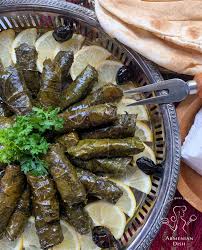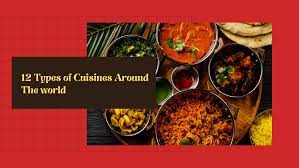Exploring Authentic Armenian Cuisine: Delectable Recipes to Try

The Delights of Armenian Cuisine: Authentic Recipes to Try
Armenian cuisine is a treasure trove of flavours, combining influences from the Mediterranean, Middle East, and Eastern Europe. From hearty stews to delicate pastries, Armenian dishes are a celebration of fresh ingredients and time-honoured traditions. Here are some authentic recipes for you to recreate the magic of Armenian cooking in your own kitchen:
Dolma
A beloved dish in Armenian households, dolma consists of grape leaves stuffed with a mixture of rice, minced meat, onions, and aromatic herbs. The rolls are then gently simmered in a tangy tomato sauce until tender. Serve with a dollop of creamy yogurt for a truly satisfying meal.
Lavash
Lavash is a thin and soft flatbread that holds a special place in Armenian cuisine. Made with just flour, water, and salt, this versatile bread is perfect for wrapping kebabs, scooping up dips like hummus or muhammara, or simply enjoyed on its own as a snack.
Harissa
Harissa is a comforting wheat porridge cooked with chicken or lamb, seasoned with butter and warming spices like cinnamon and cumin. This hearty dish is often enjoyed during festive occasions and family gatherings, bringing warmth and comfort to all who savour it.
Pakhlava
Pakhlava is Armenia’s answer to baklava – layers of flaky pastry filled with nuts and sweetened with syrup or honey. The combination of crunchy nuts and sticky sweetness makes this dessert an irresistible treat that is sure to satisfy your sweet tooth.
Armenian cuisine is not just about food; it’s about sharing stories, creating memories, and celebrating life’s moments around the dining table. So why not bring the flavours of Armenia into your home with these authentic recipes? Explore the culinary heritage of Armenia and embark on a delicious journey that will delight your taste buds and nourish your soul.
Exploring Armenian Cuisine: Six Tips for Authentic Flavours and Dishes
- Experiment with traditional Armenian spices like paprika, cumin, and coriander for authentic flavour.
- Incorporate fresh herbs like parsley, mint, and dill to add a burst of freshness to your dishes.
- Don’t be afraid to use plenty of garlic in your recipes – it’s a staple ingredient in Armenian cuisine.
- Try making traditional dishes like dolma (stuffed grape leaves) or khorovats (grilled meat skewers) for an authentic taste of Armenia.
- Explore Armenian desserts like baklava and gata to satisfy your sweet tooth with unique flavours.
- Pair your Armenian dishes with local wines such as Areni for a complete culinary experience.
Experiment with traditional Armenian spices like paprika, cumin, and coriander for authentic flavour.
To truly capture the essence of Armenian cuisine, it is essential to experiment with traditional Armenian spices such as paprika, cumin, and coriander. These aromatic spices not only add depth and complexity to dishes but also infuse them with an authentic flavour that is characteristic of Armenian cooking. By incorporating these key ingredients into your recipes, you can elevate your culinary creations to new heights and experience the rich tapestry of flavours that define Armenian gastronomy.
Incorporate fresh herbs like parsley, mint, and dill to add a burst of freshness to your dishes.
To elevate the flavours of your Armenian cuisine recipes, consider incorporating an array of fresh herbs such as parsley, mint, and dill. These vibrant herbs not only infuse your dishes with a burst of freshness but also bring a delightful aromatic quality that enhances the overall taste experience. Whether sprinkled as a finishing touch or finely chopped for a more integrated flavour, the addition of these fragrant herbs can truly elevate your culinary creations to new heights.
Don’t be afraid to use plenty of garlic in your recipes – it’s a staple ingredient in Armenian cuisine.
In Armenian cuisine, don’t hesitate to incorporate generous amounts of garlic into your recipes. Renowned as a staple ingredient, garlic adds depth and richness to dishes, infusing them with its distinctive aroma and flavour. Embracing the boldness of garlic not only enhances the authenticity of Armenian cuisine but also elevates the overall taste experience, creating dishes that are robust and full of character. So go ahead, unleash the power of garlic in your cooking and savour the true essence of Armenian culinary traditions.
Try making traditional dishes like dolma (stuffed grape leaves) or khorovats (grilled meat skewers) for an authentic taste of Armenia.
For an authentic taste of Armenia, immerse yourself in the culinary delights of traditional dishes such as dolma (stuffed grape leaves) and khorovats (grilled meat skewers). These iconic Armenian recipes not only showcase the rich flavours and textures of the region but also offer a glimpse into the cultural heritage and traditions that have shaped Armenian cuisine over generations. Whether you’re hosting a gathering or simply craving a taste of something new, exploring these beloved dishes will transport your senses to the vibrant kitchens of Armenia.
Explore Armenian desserts like baklava and gata to satisfy your sweet tooth with unique flavours.
Indulge your sweet tooth with a taste of Armenia by exploring traditional desserts such as baklava and gata. These delectable treats offer a unique blend of flavours and textures that are sure to delight your palate. Baklava, with its layers of flaky pastry and nuts drenched in syrup, provides a symphony of sweetness and crunch. On the other hand, gata, a rich and buttery pastry filled with sweet filling, offers a comforting and satisfying experience. Don’t miss out on the opportunity to savour these Armenian delights that are steeped in history and culture.
Pair your Armenian dishes with local wines such as Areni for a complete culinary experience.
When indulging in Armenian cuisine recipes, enhance your dining experience by pairing your dishes with local wines like Areni. This exquisite wine, derived from the indigenous Areni grape variety cultivated in the Armenian highlands for centuries, complements the rich and diverse flavours of Armenian dishes perfectly. The fruity notes and subtle undertones of Areni add a delightful dimension to your meal, elevating it to a truly complete culinary experience that embodies the essence of Armenian gastronomy.


